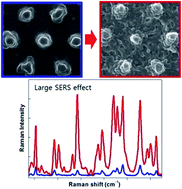Porous metallic nanocone arrays for high-density SERS hot spots via solvent-assisted nanoimprint lithography of block copolymer†
Abstract
Porous nanostructures have been enthusiastically investigated for SERS application thanks to the internal nanogaps or protrusions acting as effective electromagnetic hotspots. In this work, we report a facile fabrication method of highly porous metallic nanocone arrays for SERS application by integrating solvent-assisted nanoimprint lithography and selective etching of block copolymer (PS-b-PMMA) film. By taking advantage of the solvent-assisted nanoimprint, we easily mould the block copolymer film under atmospheric pressure and moderate temperature below the glass transition temperature in a short time. Then, the PMMA domain of the patterned block copolymer film was selectively etched to make porous structures to form dense nanogaps and protrusions. After Ag deposition, the fabricated structure exhibited a maximum enhancement factor (EF) up to ∼3.5 × 106. In comparison to Ag coated “solid” nanocone arrays, the EF of “porous” nanocone arrays is maximum ∼8.9 times enhanced, which demonstrates the effectiveness of the internal nanogaps and protrusions as plasmonic hot spots. Our fabrication method is very time-saving and cost-effective with good SERS enhancement and also can be easily applied to conventional SERS substrates or other applications that utilize porous structures.


 Please wait while we load your content...
Please wait while we load your content...